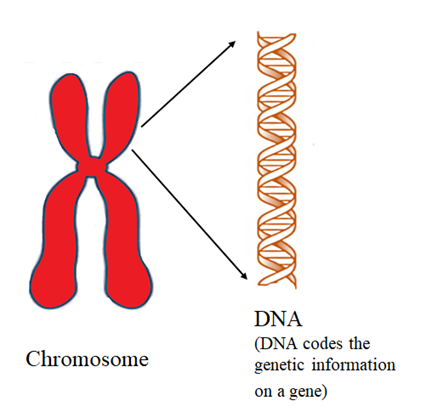
Gene is made up of:
(a) Deoxyribonucleic acid (DNA)
(b) Ribonucleic acid (RNA)
(c) Proteins
(d) Enzymes
Answer
575.1k+ views
Hint: A gene is considered as a physical and functional unit of heredity. It is also called as blue-print of life i.e. it contains all the information related to the structure, the function of organs, and various processes that are essential for life.
Complete answer:
A sequence of nucleotides in DNA that contains all the information required for the synthesis of a particular protein is called Gene. So, we can say that the gene for (say) albumin is certain base pairs long i.e. the stretch of a fixed number of nucleotides of the DNA have complete information for the synthesis of albumin. This stretch would then be called a gene for albumin.
Additional information:
The term ‘gene’ is derived from the Greek word ‘gonos’ which means offspring and procreation. It was first introduced by Wilhelm Johannsen in 1909. He was a Danish plant physiologist and geneticist. For a gene to be expressed, it is first copied into RNA and the process of copying is called Transcription. In this process, an enzyme called RNA polymerase copies the sequence of one gene from the DNA to RNA. In the process of translation, the nucleotides on RNA are read in groups of 3 which we call codons. Each codon codes for one type of amino acid. Then the ribosomes synthesize the protein by reading the codons on the RNA.
So, the correct answer is ‘Deoxyribonucleic acid (DNA)’.

Note: DNA is basically a polymer of nucleotides. Certain fixed numbers of nucleotides on DNA are termed as a gene only when they have complete information for the synthesis of one functional protein. An immense number of genes, together make up one chromosome and all the chromosomes together form the genome of an organism. The number of chromosomes varies among species.
Complete answer:
A sequence of nucleotides in DNA that contains all the information required for the synthesis of a particular protein is called Gene. So, we can say that the gene for (say) albumin is certain base pairs long i.e. the stretch of a fixed number of nucleotides of the DNA have complete information for the synthesis of albumin. This stretch would then be called a gene for albumin.
Additional information:
The term ‘gene’ is derived from the Greek word ‘gonos’ which means offspring and procreation. It was first introduced by Wilhelm Johannsen in 1909. He was a Danish plant physiologist and geneticist. For a gene to be expressed, it is first copied into RNA and the process of copying is called Transcription. In this process, an enzyme called RNA polymerase copies the sequence of one gene from the DNA to RNA. In the process of translation, the nucleotides on RNA are read in groups of 3 which we call codons. Each codon codes for one type of amino acid. Then the ribosomes synthesize the protein by reading the codons on the RNA.
So, the correct answer is ‘Deoxyribonucleic acid (DNA)’.

Note: DNA is basically a polymer of nucleotides. Certain fixed numbers of nucleotides on DNA are termed as a gene only when they have complete information for the synthesis of one functional protein. An immense number of genes, together make up one chromosome and all the chromosomes together form the genome of an organism. The number of chromosomes varies among species.
Recently Updated Pages
Master Class 12 Business Studies: Engaging Questions & Answers for Success

Master Class 12 Economics: Engaging Questions & Answers for Success

Master Class 12 English: Engaging Questions & Answers for Success

Master Class 12 Maths: Engaging Questions & Answers for Success

Master Class 12 Social Science: Engaging Questions & Answers for Success

Master Class 12 Chemistry: Engaging Questions & Answers for Success

Trending doubts
What is meant by exothermic and endothermic reactions class 11 chemistry CBSE

Which animal has three hearts class 11 biology CBSE

10 examples of friction in our daily life

One Metric ton is equal to kg A 10000 B 1000 C 100 class 11 physics CBSE

1 Quintal is equal to a 110 kg b 10 kg c 100kg d 1000 class 11 physics CBSE

Difference Between Prokaryotic Cells and Eukaryotic Cells




